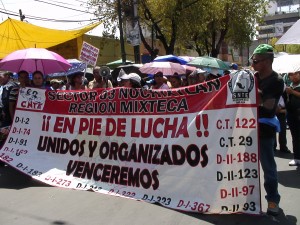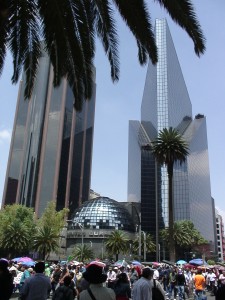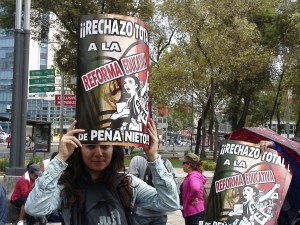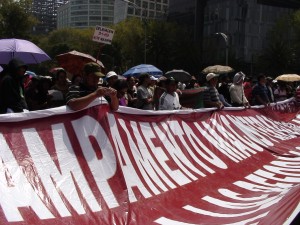By Laura Carlsen and Alfredo Acedo

Mexico’s President Enrique Peña Nieto, as any head of state, had hoped that the occasion of his first State of the Union Address would be an upbeat, if somber, affair. He had prepared his list of achievements and promises with care. But this Sept. 1, the day the address must be delivered by law, was instead a reflection of a nation in turmoil.
During the entire week before, tensions mounted. Members of the National Coordinating Body of Education Workers (CNTE, by its Spanish initials) demonstrated on a daily basis, amid rumors of a government crackdown. In the tent city set up in Mexico City’s central plaza, thousands of teachers continued to sleep, eat and protest as they had for the past two weeks.
As protesters blocked legislative offices and streets, President Peña Nieto announced that he would deliver the September 1 state of the union address in Camp Marte, a military center, as if the nation were under siege. After that caused a stir, he changed his mind and took the unusual step of delivering the report to Congress on the Sept. 1 opening day of sessions and reading it the following day in Los Pinos, the official residence.
The CNTE is the democratic current within the mammoth National Education Workers Union (SNTE), Mexico’s most powerful union and the largest labor organization in the Americas. The SNTE, on the other hand, is renown for corruption and politicking. The democratic teachers have sought to challenge the iron rule of union bosses through grassroots labor organization. The CNTE groups thousands of education workers and has won elections in several sections throughout the country.
The most combative local, Section 22 of the southern state of Oaxaca, has spearheaded the recent round of demonstrations against the president’s education reform bill.
Whose Education Reform?
The reform proposed by President Peña Nieto began with reforms to two Articles of the Constitution, already approved by Congress. The reform to Article 3 makes a Bush-like “No Child Left Behind” test required for job security and salary levels for teachers part of the constitution. Art. 73 gives schools the capacity to do private sector fundraising to finance basic education.
A banner born by a teacher with the weathered face of a farmer rejected the reform “because it will force parents to pay for education that should be free”.
A professor of the telesecondary school, Isaias Jaime Ignacio Cruz of the Mixtec region of Oaxaca, defines the consequences of the changes in Art. 73, “By making the schools autonomous so they can do their own fundraising, it opens the door to private interests and lets the government ignore its obligation to education.”
“We’re demanding that the reforms of Arts. 3 and 73 be repealed,” he explained. “Because these constitutional changes do not benefit education. On the contrary, they are an attack on our job security and seniority and go against the right of students to a holistic and real quality education.”
This isn’t the first time in Mexican history that the principle of free, secular public education has been the subjects of protests. University students have gone on strikes and parents, students and teachers have staged many demonstrations around the issue over the years. It’s one of the core revolutionary principles that strike a nerve in the national consciousness.
Mexico’s monopolized mass media has responded with alarmist claims that the city is paralyzed and the protesters are the enemies of order. The ability to drive unobstructed in a private automobile is routinely presented as a basic human right seemingly above all others, and anchors and reporters wring their hands over the “kidnapping” of the city, even though on-the-street reports show that sales and urban activity continue in what passes for normal in this chaotic city.
Chronicle of a the March
The morning of Sept. 1 dawned under a blue sky, with storms brewing in the streets. Groups of teachers left early from the Monument to the Revolution toward Los Pinos. The march was headed by teachers from the indigenous Mixtec region of Oaxaca, followed by the rest of Oaxaca and contingents from Guerrero, Puebla, Michoacan, Zacatecas, Chiapas, Jalisco, Guanajuato, Veracruz, Hidalgo, Mexico City and other smaller groups.
The education workers were joined by youth from the #IAm132 movement that emerged in opposition to the return of the PRI during the 2012 presidential elections, parents, university professors, and members of the Mexican Electricians Union, among others.
Unhurried, the column advanced down Mexico City’s stately Avenue Reforma. Thousands of men and women teachers, many indigenous, marched under crystal skyscrapers, far from their rustic schoolhouses in some of the poorest parts of the country. They passed the Senate where they encountered the first unit of police, decked out in anti-riot gear. Protesters chanted.“Mr. Policeman, I pity you, you bear the arms but you can’t protest” as the men in blue stood immobile on the steps of the Senate building.
The teachers carried banners that identified their organization and place of origin. Hand-lettered and mass-produced signs demanded the repeal of the reforms. Many read simply “Total rejection of Peña Nieto’s education reform”.
As an indication that they are not planning to quit any time soon, several carried signs warning, “If there is no justice for the people, there will be no rest for the government”.
“If education is in crisis, and it is,” Ignacio Cruz admits, “it isn’t because of us, but because the federal government decides, administers and applies policies and budgets and in the end it takes stock and blames its own shortcomings on the teachers. We try hard to make due with the little they give us—if there’s no chalk in a school, we buy it out of our own salary, same with blackboards or when a student doesn’t have the money for a birth certificate. Because we see that our students are smart–not mediocre or lazy–and we want to educate them as citizens. Not conformists or consumers, but critics and men and women who aspire to progress.”
For the Mixtec teacher, the education reform violates both labor rights and indigenous values. He notes that in the communities of Oaxaca there’s the tradition of “tequio”–a form of collective work to resolve the needs of the community. “So this tequio with people who are aware and educated makes our peoples grow; unfortunately, the reforms emphasize individualism and don’t seek harmony and the community interest.”

“They want the poor to learn English and computation to continue to exploit us, and the rich go to private schools,” warns a voice over the loudspeaker.
Other signs held by the teachers read “Evaluate Peña Nieto!” referring to the new mandatory educational evaluation, one of the most controversial points of the reform. The members of the CNTE claim that they are not against an evaluation, but reject the type of standardized evaluation proposed and the criteria designed by big business that fail to take into account different cultural contexts, the limitations with which they work, and socioeconomic differences and that generate job insecurity and punitive measures against teachers.
Sarvia Anali Valverde says, “Many say that we are against the evaluation, but what we reject is the standardized evaluation. We want an evaluation based on the training we receive, and in accordance with our working conditions, because it’s not the same to work in an community where there are no possibilities of on-the-job training, as to be in the city with more options and academic opportunities.”
In front of the Stock Market the march stops temporarily. A leader tells the crowd that the Chamber of Deputies has decided to bring up the vote on the last piece of supporting legislation, the Law of Teaching Service Docent, that same day to lock the reforms into place. He says the three major parties—the ruling Institutional Revolutionary Party (PRI), national action (PAN) and Party of the Democratic Revolution (PRD)—have agreed to support the legislation and approve it immediately, without waiting for results from the negotiation process.
The announcement causes a buzz and cries of “Traitors!” The speaker instructs the marchers to gather with their group to analyze a change in strategy. Within minutes it’s decided to change course to march to San Lazaro, the seat of the Chamber of Deputies.
It’s impressive the endurance of these teachers. Men and women have spent the past two weeks sleeping under tarps downtown, weathering the almost-daily torrential downpours of the rainy season, eating what they can get, struggling to find a place to go to the bathroom, wash clothes or bathe. But they agree readily to walk across the city under a fierce sun to reject “the betrayal of the government”.
Ignacio Cruz condemns the legislative’s rush to push the law through. “It shows their betrayal and deceit of the legislators that had said that the Law of Teaching Service would be suspended while we are in negotiations, but as faithful servants’ to the powerful they’re carrying out orders.”
Shortly after 2, the march arrives close to the Chamber of Deputies. A barricade that looks like the US-Mexico border wall blocks access to the grounds. The teachers, behind a police line, stop about 50 yards away. They don’t seek a confrontation, nor do the police. The marchers warn of the presence of provocateurs and seek to separate their ranks from any signs of trouble.
In the lanes on the other side of a camellon the youth contingent presses forward in small bunches. Suddenly a skirmish breaks out, with some tossing objects and launching bottle rockets toward the police. The teachers respond by forming a chain around their march, and begin to chant “no violence”.
Several speakers note that their fight this time isn’t for wages or traditional union demands, but for the future of their labor right and for public education.
A peculiar object appears in the sky, advancing slowly several yards above the marchers. The size of a toy airplane, it turns out to be a mini surveillance drone, a new toy of the federal police. The tiny spy plane causes general hilarity among the marchers and outright laughter when someone launches a firecracker in its direction. The flying camera does a sudden U-turn and hightails it back to where it came from. The protesters hoot–they see it as a small victory in a battle that is permanently stacked against them.
The teachers improvise a press conference in the street. Juan José Ortega, leader of section 18 of the state of Michoacán, states, “We know that we’ve opened up dialogue, we’ve presented very specific proposals, but we also know that our willingness to negotiate is not enough to convince deputies and senators who are toeing the line.”
Approving the law on teaching service “would demonstrate that they’re in the pocket of private initiative; they’d be carrying out the initiatives and prescriptions of the OECD, of Mexicanos Primero, of the Coparmex (Business Confederation of the Mexican republic), of the rest of the political-business class that has taken over our country through the rotten Pact for Mexico,” affirms Ortega. The intention to rush to vote appears to confirm the view.
The teachers have reached an impasse. Not only are they faced with a police barricade that prevents them from moving forward, they also face a presidency and Congress that have announced their intention to ram through the education reform without them.

Ruben Nuñez of Local 22-Oaxaca, says the CNTE’s battle to democratize the union is a battle to democratize the country and establish a real educational reform, built on the participation of those who are in the classroom every day, in every state of the union.
He concludes, “We are not going back to the classroom until we have been heard by the Deputies and Senators, until we have been heard by the ministries of Government and Public Education, and by the underhanded president of our country.”
“This Coordinating Body, with 34 years of struggle, will continue to demand repeal of the reform by using our best arms: unity and organization”
To confront the media campaign against the teachers’ movement, the leader of Section IX, Francisco Bravo lists the “lies about the CNTE” to reporters and the public: that the teachers don’t want to be evaluated, that they don’t want to improve education, that the protesting teachers are a small group (‘if we’re just a few why did the government have to move the State of the Union Address to a bunker and surround the Congress?’), that legislators are responding to the movement and taking their demands into account. Bravo addressed the claims one by one, pointing to alternative proposals, offers to negotiate and the strength of the movement.
“They might be able to impose legislation, they might be able to approve their education reform, but they cannot change what happens in the classrooms because to change the practice in the schools, the ones who have to be approving and discussing this are us the teachers and we have been the ones excluded from this process,” he stated.

The union leaders announced another march, stating, “twenty-one states will carry out actions against this likely imposition. We will call an insurrection.”
“We will continue to fight back in the classrooms, continue to propose alternatives, because the stakes are clear. This is not over—it’s barely beginning. The teachers say to the public and to Congress… this protest will not end here,” Bravo concluded.
That night legislators, who claimed they had integrated some modifications including a less rigid evaluation and other proposals of the teachers, approved the Law.
With the teachers in the streets, massive demonstrations against privatization of the state-owned oil company, and new reforms and new protests in the wings, the first year of President Peña Nieto’s administration looks like it will end as rough as it started out.
Laura Carlsen is director of the Americas Program. Alfredo Acedo is a journalist and director of communications for UNORCA. Published by www.cipamericasprogram.org
Photos: Alfredo Acedo



